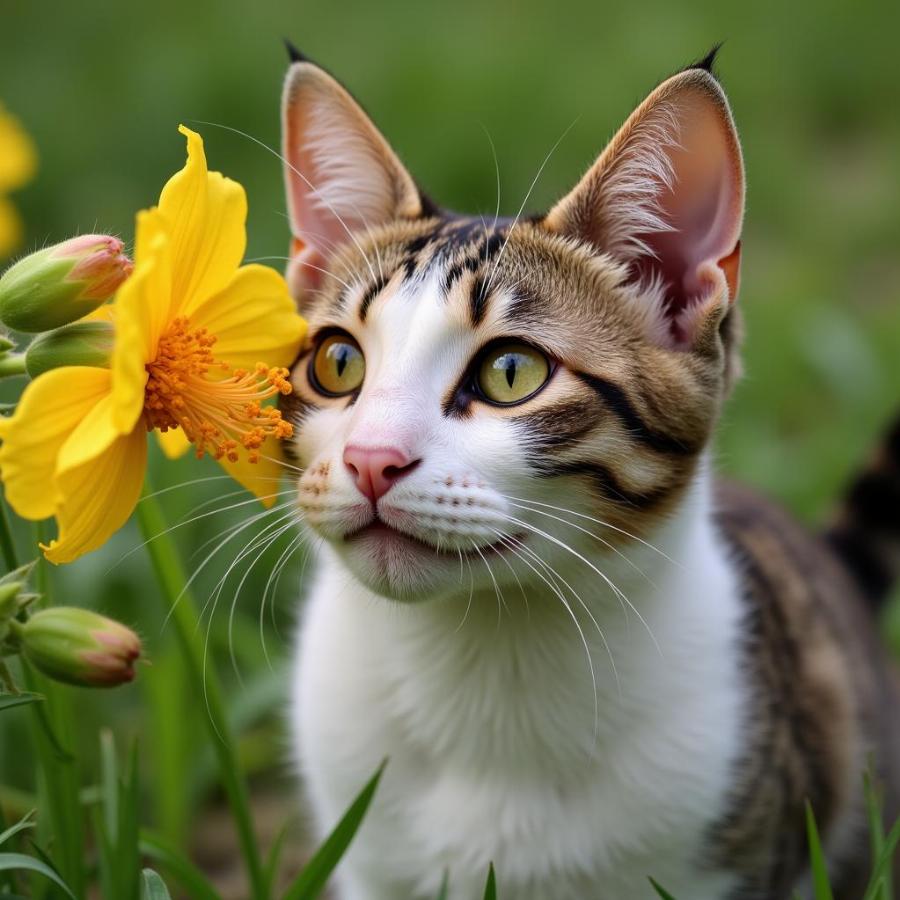The age-old debate: who has the superior sniffer, cats or dogs? While dogs are renowned for their incredible olfactory abilities, cats often get underestimated in this department. This article dives deep into the fascinating world of feline and canine scents, comparing their unique smelling superpowers and exploring how they use this vital sense in their daily lives.
Decoding the Canine Nose: A Masterpiece of Olfaction
Dogs are undeniably olfactory champions. Their noses possess up to 300 million olfactory receptors, compared to a human’s meager 6 million. This massive receptor count allows them to detect scents at concentrations nearly 100,000 times lower than what we can perceive. Their wet noses help capture scent particles, and a dedicated olfactory area in their brain processes this information with remarkable precision. This incredible sense of smell plays a crucial role in everything from tracking prey to recognizing their owners.
The Feline Sniffer: A Secret Weapon
Cats, despite their reputation for being more visually oriented, possess a surprisingly sophisticated sense of smell. While their olfactory receptor count is lower than dogs’ (around 200 million), they boast a unique organ called the vomeronasal organ (also known as Jacobson’s organ) located on the roof of their mouths. This organ allows them to detect pheromones and other subtle chemical signals, providing them with a wealth of information about their environment and other animals.
How Cats Use Their Sense of Smell
Cats use their sense of smell for a variety of purposes, including:
- Identifying territory: They mark their territory with scent glands, leaving behind chemical messages for other cats.
- Finding food: While their vision is primarily used for hunting, their sense of smell helps them locate prey and detect spoiled food.
- Recognizing their owners: Cats can distinguish their owner’s scent from others, contributing to the bond they share.
- Detecting potential dangers: Their sense of smell alerts them to potential threats, such as predators or unfamiliar chemicals.
 Mèo đang ngửi mùi
Mèo đang ngửi mùi
Cat’s Sense of Smell vs. Dog’s: A Head-to-Head Comparison
So, who wins in the scent showdown? It’s not a simple answer. Dogs excel at detecting faint scents over long distances, making them exceptional trackers. Cats, on the other hand, possess a specialized ability to detect pheromones and other subtle chemical cues, giving them an edge in understanding social and environmental information. It’s less about which sense of smell is “better” and more about the different evolutionary paths that have shaped these two remarkable species.
Which Animal Has a Better Sense of Smell for Specific Tasks?
- Tracking: Dogs are undoubtedly superior trackers due to their higher olfactory receptor count and ability to distinguish individual scents in a complex mixture.
- Detecting pheromones: Cats have the advantage in this area thanks to their vomeronasal organ.
- Identifying individuals: Both cats and dogs can recognize individuals by their scent, although dogs are generally more proficient at this task.
Improving Your Pet’s Olfactory Enrichment
Regardless of whether you have a cat or a dog, providing olfactory enrichment can significantly enhance their well-being. Simple activities like hiding treats, introducing new toys with different scents, or allowing them to explore new environments can stimulate their sense of smell and provide mental stimulation.
Conclusion: Celebrating the Unique Olfactory Worlds of Cats and Dogs
Both cats and dogs rely heavily on their sense of smell, and while their abilities differ, they are both equally fascinating. Understanding the nuances of their olfactory capabilities allows us to appreciate the remarkable sensory world they inhabit and provides valuable insights into their behavior.
FAQ
- Do cats have a better sense of smell than humans? Yes, cats have a significantly better sense of smell than humans, with approximately 200 million olfactory receptors compared to our 6 million.
- Why do dogs sniff everything? Dogs sniff to gather information about their environment, including other animals, food sources, and potential dangers.
- Can cats smell fear? While cats can detect changes in human body odor associated with stress or fear, it’s unclear whether they interpret these changes as “fear” in the same way humans do.
- How can I improve my dog’s sense of smell? Providing opportunities for scent work, such as hiding treats or playing scent-based games, can help enhance your dog’s olfactory abilities.
- Why does my cat rub its face on things? Cats rub their faces on objects to deposit pheromones from their scent glands, marking their territory and leaving behind chemical messages for other cats.
- Do cats and dogs use their sense of smell for communication? Yes, both cats and dogs use scent marking and pheromones to communicate with each other, conveying information about territory, social status, and reproductive availability.
- How does a dog’s wet nose help with smelling? A dog’s wet nose helps capture scent particles from the air, improving their ability to detect and distinguish different odors.
Suggested Further Reading
Beaut Dogs is your ultimate resource for all things canine, offering expert advice, valuable insights, and a passionate community of dog lovers. From breed information to training tips and health advice, Beaut Dogs is dedicated to helping you provide the best possible care for your furry companion. For personalized guidance and answers to your specific dog-related questions, please contact us at [email protected]. We at Beaut Dogs are here to help!